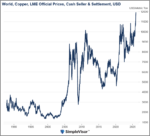- China cut tariffs on $75 bln of US imports by half, while the US said it could reciprocate in some way
- The dollar continues to climb; during the North American session, only minor data will be reported; Brazil cut rates 25 bp
- Germany reported very weak December factory orders; all is not well in the German state of Thuringia
- Czech expected to keep rates steady; Philippines cut 25 bp; India remained on hold
- Australia reported December trade and retail sales
 The dollar is broadly firmer against the majors as risk-on sentiment starts to fade and markets search for fresh drivers. Euro and Stockie are outperforming, while sterling and Nokkie are underperforming. EM currencies are also mostly weaker. KRW and IDR are outperforming, while THB and RUB are underperforming. MSCI Asia Pacific was up 1.8% on the day, with the Nikkei rising 2.4%. MSCI EM is up 1.3% so far today, with the Shanghai Composite rising 1.7%. Euro Stoxx 600 is up 0.3% near midday, while US futures are pointing to a higher open. 10-year UST yields are down 1 bp at 1.64%, while the 3-month to 10-year spread is down 1 bp to stand at +9 bp. Commodity prices are mixed, with Brent oil down 0.3%, copper up 0.5%, and gold up 0.7%.
The dollar is broadly firmer against the majors as risk-on sentiment starts to fade and markets search for fresh drivers. Euro and Stockie are outperforming, while sterling and Nokkie are underperforming. EM currencies are also mostly weaker. KRW and IDR are outperforming, while THB and RUB are underperforming. MSCI Asia Pacific was up 1.8% on the day, with the Nikkei rising 2.4%. MSCI EM is up 1.3% so far today, with the Shanghai Composite rising 1.7%. Euro Stoxx 600 is up 0.3% near midday, while US futures are pointing to a higher open. 10-year UST yields are down 1 bp at 1.64%, while the 3-month to 10-year spread is down 1 bp to stand at +9 bp. Commodity prices are mixed, with Brent oil down 0.3%, copper up 0.5%, and gold up 0.7%.
China cut tariffs on $75 bln of US imports by half, while the US said it could reciprocate in some way. While US-China tensions are likely to remain low, recent reports that that US may pull out of the WTO’s Government Procurement Act (GPA) support our view that the Trump administration will train its trade ire on other countries. Withdrawal from the GPA would mean our trading partners would lose preferential access to US government procurement tenders. Going by what we know about the trade hawks in the Trump administration, we assume they believe that the US is being taken advantage of and wants to limit foreign firms winning these bids.
Oil prices have stabilized despite the lack of agreement by OPEC and Russia on how to react to the coronavirus. Saudi Arabia is pushing for production cuts while Russia prefers extending the timeframe of the current agreement. Brent is up for the second consecutive session, gaining some 3% since recent lows. Copper has seen a similar bounce but iron ore continues to lag.
The dollar continues to climb. DXY made a marginal new high for this move near 98.333 today and is on track to test the November 29 high near 98.544. The euro remains heavy after the failed test of the $1.11 area and is struggling to stay above $1.10. Elsewhere, sterling is likely to go further sub-$1.30 while USD/JPY continues to rise. Break of the 109.55 area this week sets up a test of the January 17 high near 110.30.
AMERICAS
During the North American session, only minor data will be reported. January Challenger job cuts, Q4 unit labor costs and nonfarm productivity, and weekly jobless claims are on tap and unlikely to move markets. Overall, this week’s US data confirm our view that the US economy remains strong and that any notions of Fed easing are overdone. Kaplan and Quarles speak today. We remain bullish on the dollar even as markets await the key jobs data tomorrow. Please see our “Latest Thoughts on the US Outlook” for a deeper dive.
The Brazilian central bank took rates to record low of 4.25% with a 25 bp cut, probably the last for the cycle. The statement noted that it is “appropriate to interrupt the monetary easing process,” suggesting a wait-and-see approach after the 225 bp of total cuts since mid-2019. The swaps curve is pricing in a small chance of a hike later in the year, which seems about right for us given the pressure on the currency and the recent uptick in inflation. However, the weak economic data so far this year suggests that the odds of any tightening in the foreseeable futures are very slim. There was little reaction in FX markets but the real remains one of the worst performing currencies year to date, down nearly 5% against the dollar.
EUROPE/MIDDLE EAST/AFRICA
Germany reported very weak December factory orders. Rather than rising the expected 0.7% m/m, orders plunged -2.1% instead and dragged the y/y down to -8.7% from a revised -6.0% (was -6.5%) in November. The hard eurozone data has largely come in weaker than expected despite some improvement seen in the survey data. We remain dubious about the widely held belief that this region’s growth will pick up significantly in 2020.
All is not well in the German state of Thuringia. In a shock move, its parliament elected a leader with the support of the hard-right Alternative for Germany (AfD). This was a first in the post-unification era. Chancellor Merkel demanded that her party reverse its decision to align with AfD, calling it “a day that broke with the values and convictions of the CDU.” It’s worth noting that Thuringia was formerly in East Germany, where the far right has much more traction in party politics than in the West. Nonetheless, the development is noteworthy. Stay tuned.
Czech National Bank is expected to keep rates steady at 2.0%. CPI rose 3.2% y/y in December, the highest since October 2012 and above the 1-3% target range. December construction and industrial output and trade were reported earlier. Yesterday, December retail sales were expected to rise 6.3% y/y vs. 2.7% in November. While there are signs that the economy is slowing, high inflation should keep the bank on hold for now.
ASIA
Australia reported December trade and retail sales. The trade surplus came in slightly below consensus at AUD5.2 bln, whilst sales fell -0.5% m/m vs. -0.2% m/m expected. AUD rally has run out of steam near the .6775 area and is turning lower ahead of a big RBA day. The RBA issues its Statement on Monetary Policy tomorrow, while Governor Lowe gives his semi-annual testimony to Parliament as well.
The Philippines central bank cut rates by 25 bp to 3.75%, as most expected. The communique characterized the move as “pre-emptive” given the many headwinds ahead and the benign inflation outlook. The bank also signaled that there is room to cut further, which we fully agree with. Even though GDP remains robust at 6.4% y/y, CPI is running below the 3.0% target and the peso has been remarkably stable over the last several months trading, roughly in a 1% range against the dollar since November.
The Reserve Bank of India left rates on hold at 5.15%, as expected. There is still a risk of further easing, but the RBI is caught between the a relatively weak economy, external headwinds, and the impact of the fiscal stimulus still to come. CPI also continues on its upswing, now at a multi-year high of 7.4% y/y and well above the RBI’s 2-6% target range. Prices are likely to subside later in the year, and that’s when further easing could materialize. Meanwhile, the bank’s operation twist policies continue to pressure yields lower at the long end, while its liquidity provisions will act on the short end of the curve.
Full story here Are you the author? Previous post See more for Next postTags: Articles,Daily News,newsletter
































